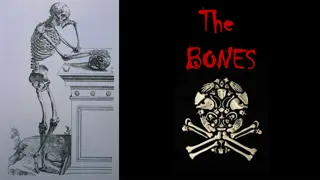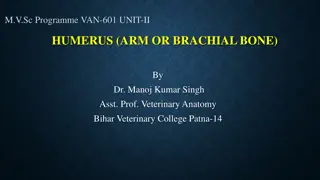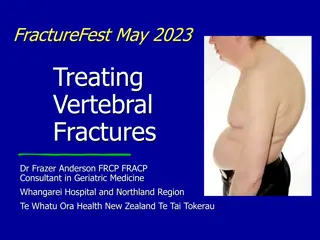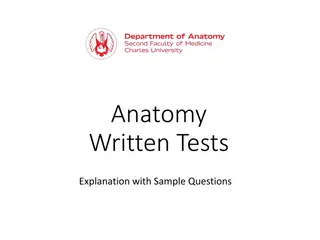Veterinary Anatomy: Tarsal Bone Structure and Function
The veterinary anatomy lesson delves into the intricacies of the tarsal bone in oxen, detailing its composition, arrangement of short bones, and specific features like the tuber calcis and articulation points. The tarsus comprises different rows of bones, each serving a specific function in locomotion and support. Detailed descriptions and accompanying images provide a comprehensive understanding of the tarsal bone's anatomy and its importance in the skeletal system of animals.
Download Presentation

Please find below an Image/Link to download the presentation.
The content on the website is provided AS IS for your information and personal use only. It may not be sold, licensed, or shared on other websites without obtaining consent from the author.If you encounter any issues during the download, it is possible that the publisher has removed the file from their server.
You are allowed to download the files provided on this website for personal or commercial use, subject to the condition that they are used lawfully. All files are the property of their respective owners.
The content on the website is provided AS IS for your information and personal use only. It may not be sold, licensed, or shared on other websites without obtaining consent from the author.
E N D
Presentation Transcript
Instructor- DR. SANJAY KUMAR BHARTI HOD, VETERINARY ANATOMY
TARSAL BONE- OX The tarsus is composed of five short bones arranged in below: Medial Proximal row Tibial tarsal Lateral Fibular tarsal Central row Fused Central and 4th tarsal Distal row First tarsal Fused second & third tarsal
It is the largest tarsal, is placed postero-lateral to tibial tarsal. It has body and medial process The body is prolonged above as tuberous to form the tuber calcis or calcaneal tubercle or Point of Hock + Achilles Tendon-Gastrocnemius. Medial process from here thick projection extended which articulated with tibial tarsal that is known as the sustentaculum tali. The lateral face of the body is flat and rough while the medial face presents two facets for the tibial tarsal. .
Tarsal bone located just below the tibia bone & elongated pully like. It has six surfaces. Proximal, Distal,Anterior, Posterior, Lateral & Medial. The proximal face form a trochlea with two vertical ridges + Tibia bone. Distal face having 2 condyles articulates with the fused central and 4th tarsal. The Anterior face having a deep fossa. The Posterior face- smooth. The Lateral face is more depressed and shows two facets for the fibular tarsal The Medial face is flat and rough .
- Plate like bone extends throughout the entire thickness of the joint Having 6 surfaces- Proximal, Distal,Anterior, Posterior, Lateral & Medial The proximal/Dorsal face presents two concave areas for the condyle of tibial tarsal. The distal/ face is uneven. The medial half is higher in level and presents a large facet in front for second and third tarsal and a small facet behind for the first tarsal. The lateral half presents two facets separated by a transverse groove and articulates with the large metatarsal bone. Anterior, Lateral & Medial- Rough and continuous (semicircle in outline) Posterior- Irregular
It is a small round piece of bone or small nodules like bone situated at the postero-medial aspect of the tarsus. Having 3 articular surface- The Proximal face articulates with the fused central and 4th tarsal. The Distal face with the large metatarsal The Anterior face with the fused second and third tarsal.
Look like one-fourth piece of a thick coin It is placed beneath the fused central and 4th tarsal on its medial aspect. Having 6 surfaces The Proximal face is concavo-convex from before backward and articulates with the fused central and 4th tarsal. The Distal face articulates with the large metatarsal. The Plantar face has a facet for the first tarsal. The Anterior, Lateral and Medial faces are continuous, convex and rough.
The tarsus is composed of Six short bones arranged in below: Medial Proximal row Tibial tarsal Lateral Fibular tarsal Central row Central Distal row Fused 1st& 2ndtarsal 3rdTarsal 4thTarsal
In the tibial tarsal, the ridges of the trochlea curve obliquely downward and outward. The lateral face has no facets for the fibular tarsal. The fibular tarsal is short and thick. It does not articulate with the lateral malleolus. The medial process is larger. The central tarsal (scaphoid) is not fused to the fourth tarsal (cuboid). It is flat and irregularly quadrilateral. The proximal face is concave and articulates with the tibial tarsal. The distal face is convex and articulates with the third tarsal and the fused 1st and 2nd tarsal. The dorsal and the medial borders are continuous and rough. The lateral border is oblique and has two faces for the cuboid. .
The fused 1st and 2nd tarsal (cuneiform parvum) is irregular in shape. The medial face is convex. The lateral face is concave. The proximal face is concave and has two facets for the central tarsal. The distal face articulates with the large and the medial small metatarsals. The plantar end is prolonged downward into a nodular projection. The third tarsal (cuneiform magnum) is triangular in outline. The proximal face is concave and articulates with central tarsal. The distal face is convex and is for the large metatarsal. The medial border has no facet for the fused 1st and 2nd tarsal and the lateral has two facets for the fourth tarsal. The fourth tarsal (cuboid) has six surfaces. It is not fused to the central tarsal. The proximal face is convex transversely and is for the fibular tarsal and the tibial tarsal. The distal face presents two facets separated by a sagittal ridge for the lateral small metatarsal bones. The medial face has facets for the central and the third tarsal. The dorsal, lateral and the plantar surfaces are convex and rough
The tarsus is composed of Seven short bones arranged in below: Medial Proximal row Tibial tarsal Lateral Fibular tarsal Central row Central Tarsal Distal row 1stTarsal 2ndTarsal 3rdTarsal 4thTarsal
The tarsus is composed of Seven short bones arranged in below: Medial Proximal row Tibial tarsal Lateral Fibular tarsal Central row Central Tarsal Distal row 1stTarsal 2ndTarsal 3rdTarsal 4thTarsal
1- Fibular tarsal is elongated. 2-Tibial tarsal has a head, body and neck. 3-Central tarsal articulates with little with all. 4- First tarsal is quadrilateral in shape. 5- Second tarsal is smallest. 6- Third tarsal is wedge shaped. 7-Fourth tarsal irregular cube like.
Fowl The tarsus bone is absent as such in the adult. In the proximal row the embryonic elements fuse with the tibia and in the distal row with the metatarsus.























